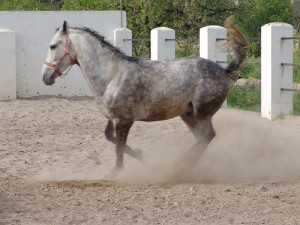 Have you ever been in a tough situation with a horse where it seems like to quit would be training him that he can get away with doing the wrong thing? It’s a principle we’ve all heard of before: Don’t let the horse win or he’ll fight you every time. But there’s quite a bit of evidence to the contrary.
Have you ever been in a tough situation with a horse where it seems like to quit would be training him that he can get away with doing the wrong thing? It’s a principle we’ve all heard of before: Don’t let the horse win or he’ll fight you every time. But there’s quite a bit of evidence to the contrary.
Take a fearful colt that’s never had a halter on in his life. You get him cornered in a stall and are working with the lead rope and halter, and just about get the halter over his nose when he just can’t stand it and pulls away. You work a little longer, working him into the corner, and get the halter near his nose again, and he pulls away and runs again. Have you lost the battle here? Are you teaching him to always pull away? Not really, if you remain calm and patient and keep working with movements that don’t heighten the colt’s anxiety. Repeating what you had done before and trying for a little more progress, however many times it takes, will most likely end up in a haltered colt that has learned to not be afraid of you. Letting him escape may give him a more relaxed look at being touched, while forcing the issue or keeping him in a stranglehold while he’s trying to bolt will do more harm than good.
Another example would be riding a young horse out on the trail, coming up on an obstacle that he is genuinely afraid of or wary about crossing. A rider that is not sensitive to the horse might urge the horse forward strongly, apply a lot of pressure, and even spur him if necessary to get the horse past or over the obstacle. The rider’s mindset is that the horse should always do what it is asked, and if not then the rider should make him do it, otherwise the horse will learn to always refuse obstacles. But this is not a correct mindset to have if you’re training a young horse, and the pressure put on the horse in the situation will create more fear and agitation in the horse, causing more problems in the future. When you ask too much of a horse at the wrong time, you create a battle that could have been avoided, and instill a distrust in the horse. A better solution to the problem would be to let the horse stop and inspect the obstacle, take some time to let him get over his apprehension, ask for movement in an arc that brings him closer to the obstacle but not directly at it, and eventually getting the horse over it. The horse needs the freedom to stay true to his self-preservation instincts, and robbing him of those is something he will remember for a long time and distrust you for.
The disclaimer on this article is that there is a difference between a horse that is learning something new and a horse that has no respect and is just testing its rider. A horse that is genuinely afraid of something should be handled with patience and given time to think through it. A horse that is refusing to yield to the rider’s cues out of stubborness is a different matter and should be worked more strongly to get the correct response.
Any way you look at it, patience is a key factor to working with horses, and the more you use it the better horse trainer you’ll be.
I wrote this article for one of Liverystable.net’s newsletters. If you’d like to see more of my articles on Liverystable.net, click here.

